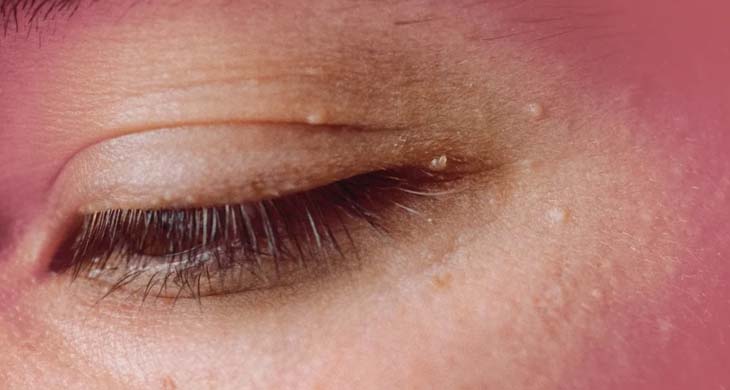ST2. Causes, Treatment, and Prevention

Eye acne, also known as a stye or eye pimple, is a common yet uncomfortable condition that affects the delicate skin around the eyes. It can cause pain, swelling, and irritation, making daily activities challenging. In this article, we will explore the causes of eye acne, available treatment options, and preventive measures to help keep your eyes healthy and free from acne.
What is Eye Acne?
Eye acne refers to small, painful bumps that develop on the eyelid or around the eye area. These bumps, known as styes or hordeolums, are often filled with pus and can cause redness and swelling. Styes usually form on the outer part of the eyelid but can also develop internally. Though eye acne is generally not serious, it can be painful and cause discomfort.
Causes of Eye Acne
1. Bacterial Infection
- Description: Eye acne is commonly caused by a bacterial infection, usually from Staphylococcus bacteria. These bacteria are naturally present on the skin but can cause infections when they enter the hair follicles of the eyelashes or oil glands.
- How it Happens: When bacteria infect the oil glands, they cause the glands to become blocked, leading to inflammation and the formation of a stye.
2. Blocked Oil Glands
- Description: The eyelids contain tiny oil glands that help lubricate the eyes. If these glands become blocked, it can lead to the formation of eye acne.
- How it Happens: Factors such as poor hygiene, excessive makeup use, or skin conditions like blepharitis can cause the oil glands to become clogged, leading to inflammation and acne around the eyes.
3. Poor Hygiene
- Description: Not maintaining proper hygiene can increase the risk of developing eye acne. This includes not washing your hands before touching your face or eyes, not removing makeup before bed, and not cleaning contact lenses properly.
- How it Happens: Dirt, bacteria, and makeup residue can accumulate on the eyelids and lashes, leading to blocked glands and infections that cause eye acne.
4. Stress and Hormonal Changes
- Description: Stress and hormonal changes can also contribute to the development of eye acne.
- How it Happens: Stress can weaken the immune system, making it easier for infections to take hold. Hormonal changes, particularly during puberty or menstruation, can increase oil production in the skin, leading to blocked glands and eye acne.
5. Chronic Conditions
- Description: Chronic conditions like rosacea, diabetes, and blepharitis can increase the likelihood of developing eye acne.
- How it Happens: These conditions can cause inflammation or affect the oil glands in the eyes, making it easier for styes to form.
Treatment Options for Eye Acne
1. Warm Compress
- Description: Applying a warm compress to the affected area is one of the most effective treatments for eye acne.
- How it Works: The warmth helps to soften the contents of the stye and promote drainage, reducing pain and swelling. Use a clean, warm cloth and apply it to the eye for 10-15 minutes, 3-4 times a day.
2. Over-the-Counter Treatments
- Description: There are several over-the-counter (OTC) treatments available for managing eye acne, including ointments and eye drops.
- Common Treatments:
- Antibiotic Ointments: These help reduce bacterial infection and speed up healing.
- Lubricating Eye Drops: These can help relieve dryness and discomfort associated with eye acne.
- Impact: These treatments can alleviate symptoms and help clear up the stye more quickly.
3. Proper Hygiene
- Description: Maintaining good hygiene is crucial for treating and preventing eye acne.
- Recommendations:
- Wash Hands Regularly: Always wash your hands before touching your face or eyes.
- Clean Eyelids: Use a gentle cleanser or baby shampoo to clean your eyelids and lashes, removing any dirt, oil, or makeup.
- Avoid Sharing Eye Products: Do not share makeup, eye drops, or contact lenses to reduce the risk of infection.
4. Avoid Squeezing or Popping
- Description: It can be tempting to squeeze or pop a stye, but this can worsen the infection.
- Why it’s Important: Squeezing the stye can push the infection deeper into the skin, leading to more severe inflammation or spreading the bacteria to other areas of the eye.
5. Medical Treatment
- Description: In some cases, eye acne may not respond to home treatments and require medical intervention.
- Options:
- Prescription Antibiotics: If the infection is severe, a doctor may prescribe antibiotic ointments or oral antibiotics.
- Incision and Drainage: For persistent or large styes, a healthcare provider may need to drain the stye surgically.
- Outcome: Medical treatment can effectively clear up the infection and prevent complications.
Prevention of Eye Acne
1. Practice Good Hygiene
- Keep Eyelids Clean: Regularly clean your eyelids with a gentle cleanser to remove dirt, oil, and makeup.
- Avoid Touching Eyes: Keep your hands away from your eyes, especially if they are dirty.
- Remove Makeup Before Bed: Always remove eye makeup before going to sleep to prevent clogging the oil glands.
2. Use Clean Eye Products
- Replace Old Makeup: Replace mascara, eyeliner, and other eye products every 3-6 months to avoid bacterial buildup.
- Avoid Sharing: Do not share eye makeup, contact lenses, or eye drops with others to prevent the spread of bacteria.
3. Manage Stress
- Practice Relaxation Techniques: Incorporate relaxation techniques like deep breathing, meditation, or yoga into your routine to manage stress.
- Get Adequate Sleep: Ensure you are getting enough sleep each night to support your immune system.
4. Monitor and Manage Chronic Conditions
- Regular Check-Ups: If you have chronic conditions like diabetes or rosacea, keep them well-managed with regular check-ups and appropriate treatment.
- Follow Doctor’s Advice: Adhere to the treatment plan prescribed by your doctor to reduce the risk of developing eye acne.
5. Maintain a Healthy Diet
- Eat a Balanced Diet: A diet rich in fruits, vegetables, and lean proteins can support skin health and prevent acne.
- Stay Hydrated: Drink plenty of water to keep your skin hydrated and reduce the risk of clogged glands.
FAQs
1. What is eye acne?
Eye acne, also known as a stye, is a painful bump that forms on the eyelid or around the eye area due to a bacterial infection or blocked oil glands.
2. What causes eye acne?
Eye acne can be caused by bacterial infections, blocked oil glands, poor hygiene, stress, hormonal changes, and chronic conditions like rosacea or diabetes.
3. How can I treat eye acne at home?
You can treat eye acne at home by applying a warm compress, maintaining good hygiene, and using over-the-counter treatments like antibiotic ointments or lubricating eye drops.
4. Should I pop a stye?
No, you should never pop or squeeze a stye as it can worsen the infection and lead to more severe inflammation.
5. How can I prevent eye acne?
Prevent eye acne by practicing good hygiene, keeping your eyelids clean, avoiding touching your eyes with dirty hands, and managing stress and chronic conditions.




